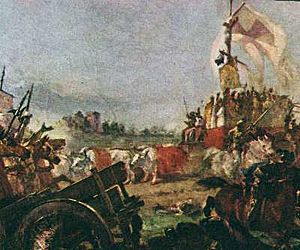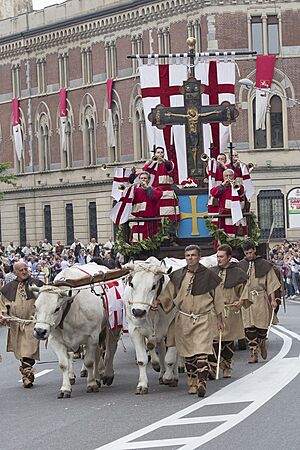Carroccio facts for kids
A carroccio (say "kah-ROT-cho") was a big, four-wheeled wagon used in battles by cities in Northern Italy during the Middle Ages. It carried the city's special flag and was a place where soldiers could gather and fight together. It was especially popular in places like Lombardy and Tuscany. Over time, other places outside Italy also started using them. The carroccio was a strong symbol of a city's freedom and independence.
Before a battle, priests would hold a church service at an altar on the wagon. Trumpeters next to them would play music to encourage the soldiers. The carroccio was protected by the bravest fighters in the army. It had the city's colors and was usually pulled by oxen. On the wagon, there was an altar, a bell (called a "martinella"), the city's symbols, and a tall pole with a Christian cross on top. When there wasn't a war, the carroccio was kept in the main church of its city. If the enemy captured a carroccio, it was seen as a huge defeat and a great shame for the city.
Contents
History of the Carroccio
Early Days
The idea for the carroccio came from the Lombards, an ancient people. At first, it was just a war chariot. But between 1037 and 1039, Aribert, the Archbishop of Milan, started using it in a new way. He added a cross, city symbols, and an altar. He also made sure it was kept in the main church when not in use. This made the carroccio more than just a military tool; it became a powerful political symbol.
From Milan, the use of the carroccio spread to many cities in northern Italy and Tuscany. Its use began to decline in the 1300s. Old documents show the carroccio was called names like carochium or carrocerum. In the Milanese language of that time, it was probably called caròcc.
The 1100s
Records from 1158 and 1201 show that Milan's carroccio was kept in the church of San Giorgio al Palazzo during peacetime. In 1159, soldiers from Brescia captured the carroccio of Cremona during a battle. They proudly carried it through the streets of Brescia and placed it in their city's church. Its bell, the "martinella," was put on the city's clock tower.
The carroccio played a very important role in the Battle of Legnano on May 29, 1176. During this battle, the city's foot soldiers bravely defended the carroccio. This allowed the rest of the Lombard League army to arrive from Milan and defeat Frederick Barbarossa. This battle showed how important the carroccio was to the cities.
The 1200s
After Legnano, other cities also started using the carroccio. Florence first used one in battle in 1228. Florence's carroccio often had a smaller cart following it, carrying the "martinella" bell to signal military commands. When war was likely, the "martinella" was hung on a church door in Florence and rung to warn everyone.
In 1237, the carroccio of the Lombard League was captured by Emperor Frederick II, Holy Roman Emperor during the Battle of Cortenuova. Frederick II then gave it as a gift to Pope Gregory IX. It was taken to the Palazzo Senatorio in Rome, where a room is still called the Sala del carroccio ("Room of the carroccio"). There's an inscription there that says:
Receive, oh Rome, the chariot, a gift of Emperor Frederick II, perennial honor of the city. Captured in the defeat of Milan, it comes as a glorious prey to announce the triumphs of Caesar. It will be held as shame to the enemy, sent here for the glory of the City, the love of Rome sent it
In 1275, the carroccio of Bologna was captured by soldiers from Forlì and taken there in triumph. Later, in the mid-1200s, the carroccio of Cremona was captured by the soldiers of Parma.
The 1300s: End of an Era
The carroccio slowly stopped being used because war tactics changed. Armies became larger and moved faster. Foot soldiers from the cities were replaced by mercenary soldiers, who were paid fighters and didn't have the same strong feelings for the city.
The carroccio, being a very slow vehicle pulled by oxen, couldn't keep up with these faster war actions. It often got in the way. Because of these reasons, the carroccio became less important in the 1300s and eventually disappeared from battlefields.
Carroccio Outside Italy
Similar wagons with flags were also used in other parts of Europe. For example, the English used one at the Battle of the Standard in 1138, and the Hungarians used one at the Battle of Sirmium in 1167. The carroccio was also used in the Battle of Bouvines in 1214.
How the Carroccio Was Used
Besides being a symbol, the carroccio had an important military purpose. It gained military value, especially after the Battle of Legnano. In that battle, for one of the first times in history, foot soldiers gathered around the carroccio were able to stand strong against knights on horseback. Before this, knights were usually seen as much stronger than foot soldiers.
If the carroccio was captured, it usually meant that the city's army was defeated. This is why the carroccio was so important in war and was kept in the main churches of cities. It was also a central part of important ceremonies and events during peacetime.
The carroccio also had other uses. City leaders could make important decisions on the carroccio. Judges could even use it as a mobile court to give out their judgments.
What the Carroccio Looked Like
Parts That Remain Today
Very few parts of the original medieval carroccios still exist. In Brescia, there is a cross that might have been on the flagpole of the carroccio from Cremona. In the Siena Cathedral, there are two large wooden poles that people believe came from the carroccio that won the Battle of Montaperti. In Cremona, at the civic museum, there is a wooden platform thought to be from the wagon captured from Milan in 1213.
What Old Stories Tell Us
Since there are so few remains, we mostly learn about the carroccio's shape from old stories and drawings. One writer, Alessandro Visconti, described it like this in 1945, based on an older account:
The sign that was to precede the fighters was like this: a tall antenna, like a ship's mast, planted in a sturdy wagon rose up high, bringing to the top a golden knob with two flaps of white hanging linen. In the midst of that antenna the venerable Cross was fixed with the image of the Redeemer painted with open arms facing the surrounding ranks, because whatever the event of the war, looking at that sign, the soldiers comforted it…
—Alessandro Visconti, History of Milan, 1945, p. 169
It seems there were probably three main types of carroccio. The "classic" one, like Milan's, a Tuscan one with two flagpoles (Florence's also had a bell), and a simpler cart with one central flagpole used in places like Flanders and Germany.
A description from 1248 tells us that a carroccio had five main parts: four wheels, a platform, a flagpole, a flag, and decorations. The wheels were very large and often painted red in Milan and Florence, or white in Parma. The flagpole was very heavy and often held up by ropes. The flag was usually made of fine fabric, often divided into two colors or decorated with a cross. Unlike in Northern Europe, Italian carroccios usually didn't have pictures of saints on them. Oxen usually pulled the carroccio, but sometimes horses were used.
The "Martinella" Bell
The "martinella" was a bell used with the carroccio. It's not clear if it was always directly on the carroccio or sometimes on a separate cart. Its main job was to call the soldiers back to the carroccio. Trumpeters would also give orders and encourage the troops to fight.
In 2000, what is believed to be the original "martinella" from the Battle of Legnano was found. It was kept in a bell tower in Ponte Nizza. That same year, it was part of the historical parade for the Palio di Legnano.
The Specialis Magister
The specialis magister was a person paid by the city to take care of the carroccio. He made sure the wagon was working properly. He also wore armor and carried a sword when the carroccio was involved in battles. A chaplain (a priest) was also on the carroccio to hold church services on the altar. The city paid this religious figure too.
Carroccio in Modern Times
Later Meanings
Since the carroccio was a symbol, it has taken on new meanings over time. During the period of the Signorias (when powerful families ruled cities), it became a symbol against unfair rulers. Later, during the Romanticism and Risorgimento periods (when Italy was becoming a unified country), it symbolized the fight against foreign control. Famous writers and artists like Massimo d'Azeglio and Giosuè Carducci helped spread these ideas.
Modern Celebrations
Today, the carroccio is often the main feature in historical festivals and re-enactments:
- In the Palio di Siena (July 2 and August 16), the carroccio parades with the city's black-and-white flag. It carries the "Palio" (a painted silk banner), which is the prize for the horse race that ends the event.
- In the Palio di Legnano (last Sunday of May), the carroccio is pulled by oxen through the streets of Legnano. This wagon carries the Cross of Aribert, the prize for the horse race where the eight neighborhoods of Legnano compete. The carroccio is escorted by people dressed as Alberto da Giussano and the Company of Death, who re-enact a famous charge from the Battle of Legnano.
- In the Palio di Asti (third Sunday of September), the carroccio is pulled by three pairs of oxen. It carries the city's flag (a white cross on a red background), an iron rooster (a symbol of city freedom), and the Palio di Asti, the prize for the horse race. It also has the "martinella" bell, which used to call soldiers to prayer before battle.
Modern Use of the Word
The political party called the Lega Nord is often known as il carroccio. This is because they refer to the Battle of Legnano and use symbols related to it.
See also
- Alberto da Giussano
- Battle of Legnano
- Company of Death
- Lombard League






